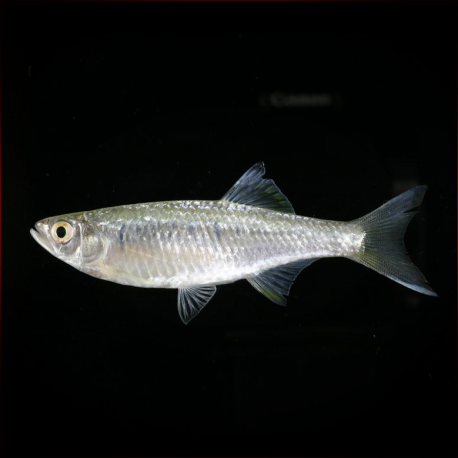More info
Datasheet
| Minimum Tank Size | 300 litres / 79.25 US gallons |
| Maximum Size | 10.0cm / 3.94inches |
| Temperature | 22°C / 71.60°F - 30°C / 86.00°F |
| Hardness | 2.02dgH / 36ppm - 15.02dgH / 268ppm |
| pH | 6.0-8.0 |
General Description
Opsarius koratensis, also known as Barilius koratensis, is a member of the Cyprinidae family within the order Cypriniformes. This species is visually distinguished by its lateral line scales numbering between 32-36, predorsal scales ranging from 15-18, a faint broad longitudinal stripe on each flank, and 2-9 faint short vertical bars on either side.
Aquarium Setup
The optimal aquarium setup for Opsarius koratensis involves replicating a flowing stream environment with a substrate comprising variably-sized rocks, sand, fine gravel, and larger water-worn boulders. Adding driftwood roots and branches is also beneficial, ensuring enough open swimming space. While most aquatic plants struggle in such conditions, attaching hardy species such as Microsorum, Bolbitis, or Anubias spp. to décor is feasible.
Behaviour
Opsarius koratensis is fast-swimming and a vigorous feeder, making it unsuitable for tanks with slow-moving or timid species, especially smaller fish that may become prey. It is social and thrives in groups of five or more individuals to establish a harmonious pecking order.
Feeding and Diet
In their natural habitat, Opsarius koratensis feed predominantly on surface insects, small fishes, and benthic invertebrates. In captivity, they can be fed high-quality dried foods supplemented with live or frozen options like bloodworms, Artemia, chopped earthworms, gut-loaded fruit flies, and crickets.
Reproduction & Dimorphism
Information on the reproduction of Opsarius koratensis is currently unreported. Adult females of this species are slightly larger, thicker-bodied, and less brightly colored compared to males, especially when gravid.
Habitat and Distribution
These fish inhabit well-oxygenated, slow to moderate-flowing rivers and streams with substrates of gravel, cobbles, larger boulders, and exposed bedrock. Opsarius koratensis is found in the middle and lower Mekong regions spanning Thailand, Laos, Cambodia, the Chao Phraya and Mae Klong systems in Thailand, and the Dong Nai drainage in Vietnam. Additionally, there is a record of this species in southern China's Yunnan province.

